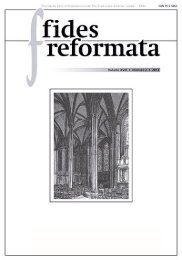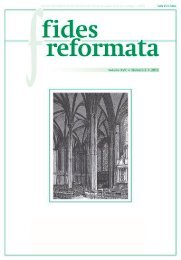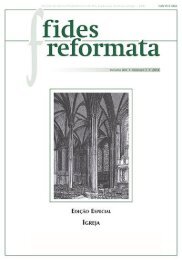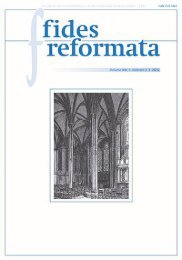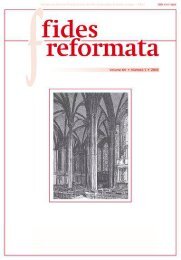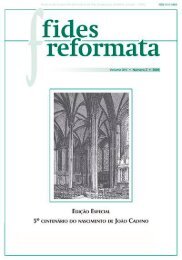Create successful ePaper yourself
Turn your PDF publications into a flip-book with our unique Google optimized e-Paper software.
P.H.R. (Rob) van Houwelingen, John and the Others<br />
The Muratorian Canon provides a hint to determine the “we-group”<br />
further, line 9-16a:<br />
The fourth of the Gospels is that of John, [one] of the disciples. (To his fellow<br />
disciples and bishops, who had been urging him [to write], he said, 'Fast with<br />
me from today to three days, and what will be revealed to each one let us tell<br />
it to one another.' In the same night it was revealed to <strong>Andrew</strong>, [one] of the<br />
apostles, that John should write <strong>do</strong>wn all things in his own name while all of<br />
them should review it. 42<br />
It was <strong>Andrew</strong>, together with the other disciple who later was called the<br />
beloved disciple, who belonged to the first disciples of Jesus (John 1:40).<br />
In line 14-15 the Latin text has the verb recognoscere: “while they all were<br />
considering it”. At the moment when it all was narrated, they remembered<br />
everything: it all actually happened that way. The Muratorian Canon relates<br />
the Fourth Gospel to recollection and recognition. John is part of a circle of<br />
eyewitnesses. We see that line 26-34 complements the reference to 1 John 1:1:<br />
What marvel is it then, if John so consistently mentions these particular<br />
points also in his Epistles, saying about himself, 'What we have seen with<br />
our eyes and heard with our ears and our hands have handled, these things<br />
we have written to you? For in this way he professes [himself] to be not only<br />
an eyewitness and hearer, but also a writer of all the marvellous deeds of the<br />
Lord, in their order. 43<br />
It appears, that John was the center of and the spokesman for a circle of<br />
eyewitnesses. Considering the relation between the prologue and the epilogue,<br />
the retrospective effect of John’s position for the prologue is that the circle<br />
around John is the same “we-group” of 1:14. John <strong>do</strong>es not identify himself<br />
with his readers there; neither <strong>do</strong>es he use a plural of authority. He knows<br />
himself to be closely bound to the other eyewitnesses who also saw the glory<br />
of the One and Only Begotten. They are part of the same “we-group” who<br />
confirms the trustworthiness of his testimony in the epilogue as written in the<br />
Fourth Gospel.<br />
42 Translation by METZGER, Bruce M. The Canon of the New Testament. Its Origin, Development,<br />
and Significance. Oxford: Claren<strong>do</strong>n Press, <strong>19</strong>87. Online: http://www.bible-researcher.com/muratorian.<br />
html. See also VERHEYDEN, J. The Canon Muratori: A Matter of Dispute. In: AUWERS, J. M. &<br />
JONGE, H. J. de (eds.). The Biblical Canons. Leuven: Peeters, 2003, p. 487-556.<br />
43 One could also discover something similar in Clement of Alexandria, Eusebius, Ecclesiastical<br />
History VI 14,7: “But that John, last of all, conscious that the outward facts had been set forth in the<br />
Gospels, was urged on by his disciples, and, divinely moved by the Spirit, composed a spiritual Gospel”<br />
(translation by J.E.L. Oulton in the Loeb-series).<br />
110






